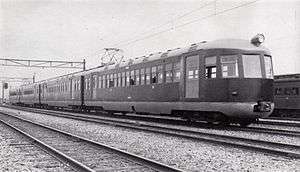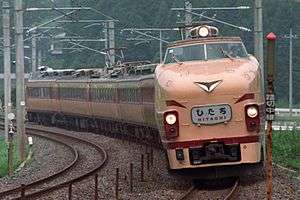52 series
The 52 series (52系) EMUs were manufactured in 1936-1937 in 3 batches and operated by Japanese Government Railways (JGR, later JNR) for use on the Hanwa Line, and later used on the San'yō Main Line, JR Kobe Line, JR Kyoto Line in the Kansai region and the Iida Line in Nagano Prefecture, Japan. The trains were developed from the 42 series EMUs.
| 52 series | |
|---|---|
 JGR Moha-52 electric multiple unit, first model, at Miyahara in 1936 | |
| In service | 1936-1983 |
| Manufacturer | Kawasaki Heavy Industries, Nippon Sharyo |
| Constructed | 1936-1937 |
| Entered service | 1936 |
| Number built | 20 vehicles |
| Number preserved | 2 vehicles |
| Operator(s) | JGR, JNR |
The 52 series EMUs were retired between 1976 and 1983.
Preserved examples

Preserved 52 series carriage KuMoHa 52004 at Sakuma Rail Park, April 2009
- KuMoHa 52001: Suita Depot, Osaka
- KuMoHa 52004: (built 1937 by Kawasaki Sharyo) SCMaglev and Railway Park, Nagoya[1]
gollark: I suspect a bunch of my names would be stolen quite fast.
gollark: And that pagination will be hobbled for some inexplicable reason to 5 pages.
gollark: Don't be ridiculous. The TJ09 works in the cover of darkness.
gollark: What are they worth *now* then?
gollark: Also, what are purple siyats actually worth these days? I got 4.
References
- "「リニア・鉄道館」ファーストガイド" ["SCMaglev and Railway Park" First Guide]. Tetsudō Daiya Jōhō Magazine. 40 (324): 20–33. April 2011.
| Wikimedia Commons has media related to 52 series. |
This article is issued from Wikipedia. The text is licensed under Creative Commons - Attribution - Sharealike. Additional terms may apply for the media files.
